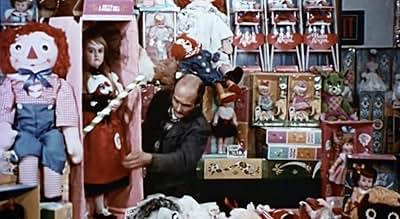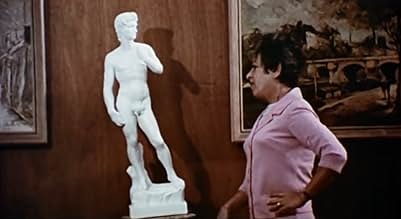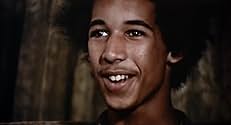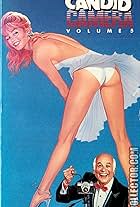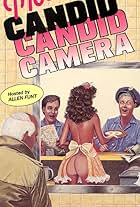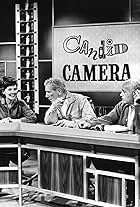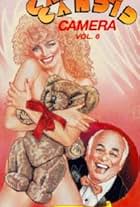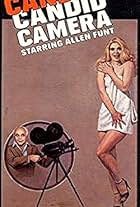Añade un argumento en tu idiomaFrom Candid Cameraman Allen Funt comes a hysterical feature films that tells and shows all. Witness America's response to one of the most titillating stunts of all time in this hilarious exp... Leer todoFrom Candid Cameraman Allen Funt comes a hysterical feature films that tells and shows all. Witness America's response to one of the most titillating stunts of all time in this hilarious expose of sex and society.From Candid Cameraman Allen Funt comes a hysterical feature films that tells and shows all. Witness America's response to one of the most titillating stunts of all time in this hilarious expose of sex and society.
Rudy Jones
- High School Student
- (sin acreditar)
Ernie Monah
- Falling Door Prank Victim
- (sin acreditar)
Harry W. Stinger
- Nudist
- (sin acreditar)
Reseñas destacadas
I love the first part where the elevator doors open and a lovely naked lady stands there to greet passengers. The candidly diverse reactions are amusing and at times surprising. The movie debuted in 1969, clearly maestro Funt's filmic response to the blooming sexual revolution of that unconventional decade. Mostly it's an entertaining collection of candid set-ups gauging people's responses to the new-found explicitness, both male and female. For example, there're women being suddenly situated with a nude male model, college kids being instructed by a nude female teacher, but mostly probing interviews with folks of all ages on changing sexual mores, some of which are over-extended, perhaps the docu's only drawback. At the same time, the setups with the elderly ladies may be the most entertaining and revealing of all. Then too, I'd love to see some of the out-takes that weren't included; I wonder what they would be.
Overall, there's not as much full frontal nudity as you might expect (strategically placed purses, etc.); nonetheless, it's a naughty and compelling Candid Camera of an unconventional era that's lost little interest over the intervening decades.
Overall, there's not as much full frontal nudity as you might expect (strategically placed purses, etc.); nonetheless, it's a naughty and compelling Candid Camera of an unconventional era that's lost little interest over the intervening decades.
This film is the famous "Candid Camera" television show in a feature format, and much more Risqu'e that could have been broadcast. But beyond the amusing laughs of Alan Funt's situations lies a surprising glimpse into the uncensored attitudes of American culture in the midst of social upheaval.
Prevailing sexual and racial attitudes are both surprising and tantalizing. Taboo subjects are tackled in an unflinching way, without comment by the filmmakers - leaving you an unobstructed view on our past culture.
Prevailing sexual and racial attitudes are both surprising and tantalizing. Taboo subjects are tackled in an unflinching way, without comment by the filmmakers - leaving you an unobstructed view on our past culture.
- Andy Somers
This movie remained a hysterical look at sex that i could not help but enjoy. The editors cut the footage perfectly in the "Spray can scene" and made me break out in laughter just watching the difference between the girls' orgasms. Different sequences with different sex related themes made this a documentary great. This docu-comedy is pure genius ***1/2 out of ****
How often does one remember only a few brief scenes from a film and find on re-viewing years later that it was only those few moments that are worth remembering? NAKED LADY, one might think, being a film of individual moments, could well be such a film. Happily, this is not the case. (Only the little kids on the lawn and the extended reprise of faces and "smile" moments at the end seemed at all tacky.) The passing years have only added to the film's value, for it turns out to be a revealing portrait of changing attitudes to sex in the late sixties, when people of all ages with open minds were receptive to new ways of thinking about sex. The film has an innocence and a hopefulness, a simple charm that we've all lost today for many reasons. It's Funt's film all the way, of course, and it's his masterpiece! His personality dominates the film; his voice constantly heard, challenging his subjects to say what they think and to think about what they say. The naked ladies in unusual places are there to sell the film, to provide entertainment value, but people are what endlessly fascinates Funt. He really likes people, and he loves to talk to them. The core scenes are all talking heads; the co-eds talking about guys on the dorm, the young people and their parents talking about sex, the woman who "prostitutes" for free because she likes it, his interview with a prospective model, even the "man in the street" comments about "how birds do it." It's no accident that the film is interracial, because Funt's belief is that you can't judge a person by their looks. Sometimes people are true to type, but just as often they're not. An IMDb viewer says that, based on his recollection, the current version differs from the original release. I wouldn't have remembered the changes he mentions, but my own recollection suggests an excision of a character in the greatest sequence in the film in which Funt, as a bus ticket clerk, feels people out on their feelings about an interracial couple. I recall clearly that there was a young, long-haired hippie type who was very outspoken against the couple, who was contrasted with the older man who says, "what's the difference, it's a big world," and prefers love to war profiteering. I did misremember that great line of the passing English bicycler at the beginning which I recalled as, "What you got there, Charlie?" when it's actually, "Charlie, how'd you get caught with that one?" But I can't see how I made up the young long-haired hippie; I'm certain he was there in the original release. The comments of the older man whose son married a Mexican girl, his difficulty in accepting the marriage so touchingly mixed with his pride in his grandchildren, again brought a lump to my throat. Moments like this must have been what Funt lived for. In his earlier days, going way back to "Candid Microphone" before TV, the emphasis was always on human interaction. (I remember, for example, a theatrical short where Funt, as a travel agent, insisted, with total courtesy and friendliness, on selling a customer a fancy vacation when they wanted something plain and simple.) The TV show had moved away from that to sight gags like cars splitting in half. This film was Funt's attempt to return to his roots. It's a very serious film by a very serious filmmaker, Funt challenging his audience to examine their own feelings and beliefs, and gently urging tolerance for the infinite variety of mankind. It's a far better, more enduring film, in fact, than some of the documentary "classics" (GREY GARDENS, for example) that were made in the same era.
My new wife and I saw "What Do You Say To A Naked Lady" in the theater back around 1970 when it was released. Thirty or so years later, I bought the VHS release of this film. Although I certainly don't claim to recall everything I saw in this film in 1970, I do recall some scenes that are omitted on the VHS release. Also, the VHS release seems to have more talking and other less interesting content, such as original reactions of the test screening audience.
In particular, I recall several iterations of the man knocking on the door, which falls in, to reveal a naked lady on the phone, who then asks him to put the door back. In the VHS release there is only one brief episode.
Also, the scene where the man is sent to wait in a room, and all other occupants are naked ladies. That is completely omitted in the VHS release. My complaint is that these scenes, which depict how different people react, contain much of the value of the lesson this film teaches.
I rate the VHS release only about 6 or 7 of 10 because of these omissions. Still, it represents a great lesson in how people react to these unusual situations, and worth seeing.
In particular, I recall several iterations of the man knocking on the door, which falls in, to reveal a naked lady on the phone, who then asks him to put the door back. In the VHS release there is only one brief episode.
Also, the scene where the man is sent to wait in a room, and all other occupants are naked ladies. That is completely omitted in the VHS release. My complaint is that these scenes, which depict how different people react, contain much of the value of the lesson this film teaches.
I rate the VHS release only about 6 or 7 of 10 because of these omissions. Still, it represents a great lesson in how people react to these unusual situations, and worth seeing.
¿Sabías que...?
- Créditos adicionales"A Film by Allen Funt" is Funt's only on-screen credit.
- ConexionesReferenced in Laugh-In: Guest Starring Debbie Reynolds (1970)
Selecciones populares
Inicia sesión para calificar y añadir a tu lista para recibir recomendaciones personalizadas
- How long is What Do You Say to a Naked Lady??Con tecnología de Alexa
Detalles
Taquilla
- Recaudación en Estados Unidos y Canadá
- 157.900 US$
- Duración1 hora 25 minutos
- Color
- Mezcla de sonido
- Relación de aspecto
- 1.85 : 1
Contribuir a esta página
Sugerir un cambio o añadir el contenido que falta

Principal laguna de datos
By what name was What Do You Say to a Naked Lady? (1970) officially released in Canada in English?
Responde


